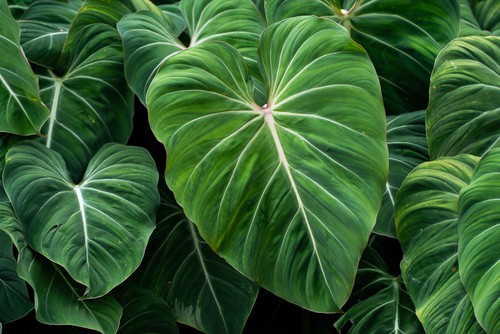Philodendrons are beautiful and popular indoor plants that are known for their large, glossy leaves. However, one common issue that many philodendron owners face is the appearance of black spots on their leaves. These spots can be alarming, especially if you’re not sure what’s causing them.
Understanding philodendrons and how to care for them is crucial in preventing and treating black spots on their leaves. There are several potential causes of these spots, including diseases, pests, and environmental factors.
Identifying the cause of the spots is the first step in determining the best course of action to take. In this article, we’ll explore the causes of black spots on philodendron leaves and provide tips on how to prevent and treat them.
Key Takeaways
- Proper care and maintenance are essential for preventing black spots on philodendron leaves
- Common causes of black spots include diseases, pests, and environmental factors
- Early detection and treatment are crucial in preventing further damage to the plant
Check out other popular posts:
Understanding Philodendrons

Philodendrons are a popular indoor plant known for their lush foliage and easy care. They are native to tropical regions of Central and South America and belong to the Araceae family. There are over 500 species of philodendrons, and they come in a variety of shapes, sizes, and colors.
Philodendrons are known for their large, glossy leaves that can grow up to 3 feet long. The leaves are typically heart-shaped or arrow-shaped and can be solid green or variegated with white, yellow, or red. They are fast-growing plants that can quickly fill a space with their lush foliage.
Philodendrons are an excellent choice for indoor plants because they are easy to care for and can thrive in low light conditions. They prefer well-draining soil and should be watered when the top inch of soil is dry. Overwatering can lead to root rot, which can cause black spots on the leaves.
In addition to overwatering, black spots on philodendron leaves can be caused by a variety of factors, including bacterial and fungal leaf spots, improper irrigation, sunburns, pests, soil salt build-up, low humidity, and environmental issues.
It is essential to identify the cause of black spots to effectively treat and prevent them from reoccurring.
Overall, philodendrons are an excellent choice for anyone looking to add some greenery to their indoor space. With proper care and attention, these beautiful plants can thrive and add a touch of tropical paradise to any room.
Recognizing Black Spots on Philodendron Leaves
Philodendrons are beautiful and easy-to-care-for plants that can add a touch of green to any space. However, sometimes they can develop black spots on their leaves, which can be a sign of a problem.
It’s important to recognize these black spots and understand what they mean so that you can take the necessary steps to keep your plant healthy.
Signs of Black Spots on Philodendron Leaves

Black spots on philodendron leaves are easy to spot, as they are dark and often have a yellow halo around them. These spots can be small or large and can appear on the top or bottom of the leaves. Sometimes, the spots can merge and cause the leaves to turn yellow, wilt, and fall off.
Causes of Black Spots on Philodendron Leaves
There are several reasons why philodendron leaves can develop black spots. One common cause is bacterial leaf spot, which is a disease caused by bacteria that can spread quickly and cause serious damage to the plant. Fungal leaf spots can also cause black spots on philodendron leaves.
Other causes of black spots on philodendron leaves include watering issues, low humidity, and pest infestations. Overfertilizing and salt build-up in the soil can also cause black spots on philodendron leaves.
Conclusion
Recognizing black spots on philodendron leaves is important for keeping your plant healthy. By understanding the signs and causes of black spots, you can take the necessary steps to prevent and treat them.
Black Spots on Philodendron Leaves – 5 Common Problems
Black spots on philodendron leaves are a common problem that many plant owners face. These spots are a sign that something is not quite right with your plant. Here are some of the most common causes of black spots on philodendron leaves:
1. Bacterial and Fungal Diseases
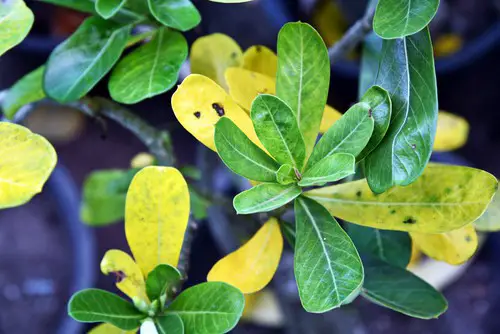
Bacterial and fungal leaf spots are the leading causes of philodendron leaves turning black. These spots start as small, water-soaked lesions that gradually enlarge and turn black.
Bacterial leaf spot disease is caused by the Xanthomonas campestris bacteria, while fungal leaf spot disease is caused by various fungi, including Cercospora, Phyllosticta, and Colletotrichum.
2. Watering Issues
Overwatering and underwatering can cause black spots on philodendron leaves. Overwatering can lead to root rot, which can cause the leaves to turn black and eventually fall off. Underwatering can cause the leaves to wilt and turn black as well.
3. Low Humidity
Philodendrons require high humidity levels to thrive. Low humidity can cause the leaves to dry out and turn black. Placing a humidifier near the plant or misting the leaves regularly can help prevent this problem.
4. Environmental Issues
Environmental factors such as low light, direct sunlight, drafts, and heat stress can also cause black spots on philodendron leaves. Philodendrons prefer bright, indirect light and temperatures between 60-75°F. They are also sensitive to cold drafts and extreme heat.
5. Pest Infestation

Pests such as spider mites, mealybugs, and scale insects can also cause black spots on philodendron leaves. These pests can suck the sap from the leaves, causing them to turn black and eventually fall off. Regularly inspecting your plants and treating any pest infestations promptly can help prevent this problem.
In summary, black spots on philodendron leaves can be caused by a variety of factors, including bacterial and fungal diseases, watering issues, low humidity, environmental issues, and pest infestations.
Understanding these causes and taking appropriate measures to prevent them can help keep your philodendron healthy and thriving.
Common Diseases in Philodendrons
Philodendrons are popular houseplants known for their attractive foliage and easy-to-care nature. However, like all plants, they are susceptible to diseases that can impact their growth and appearance. Here are some of the most common diseases that affect philodendrons:
1. Bacterial Blight
Bacterial blight is a common disease in philodendrons caused by the bacterium Xanthomonas campestris. The disease is characterized by the appearance of water-soaked lesions on the leaves, which eventually turn yellow and die.
The bacterium can also cause stem rot, which can lead to the death of the entire plant. The disease spreads through contaminated tools, soil, and water.
2. Leaf Spot Disease
Leaf spot disease is caused by various fungal and bacterial pathogens, including Cercospora, Alternaria, and Pseudomonas. The disease is characterized by the appearance of circular or irregular spots on the leaves, which can be brown, black, or yellow in color.
In severe cases, the spots can merge, causing the leaves to turn yellow and fall off. The disease spreads through splashing water, contaminated soil, and infected plant debris.
3. Anthracnose
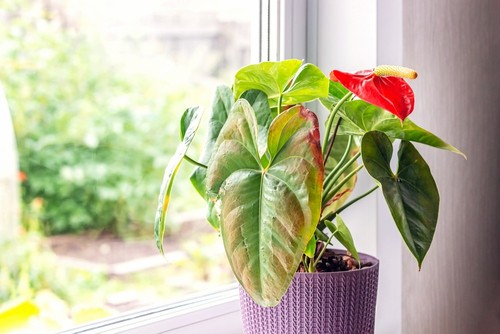
Anthracnose is a fungal disease that affects various parts of the plant, including leaves, stems, and fruits. The disease is characterized by the appearance of dark, sunken lesions on the leaves, which can cause them to wilt and die. The fungus thrives in warm and humid conditions and spreads through contaminated soil and water.
4. Fungal Infection
Fungal infections are common in philodendrons and can cause a range of symptoms, including leaf spots, wilting, and yellowing of leaves. The fungi responsible for these infections include Fusarium, Rhizoctonia, and Pythium. The disease spreads through contaminated soil, water, and infected plant debris.
5. Root Rot
Root rot is a common disease in philodendrons caused by various fungi, including Phytophthora and Pythium. The disease is characterized by the decay of the roots, which can cause the plant to wilt and die. Overwatering, poor drainage, and contaminated soil are some of the factors that can contribute to the development of root rot.
In conclusion, philodendrons are susceptible to various diseases that can impact their growth and appearance. It is essential to identify and treat the diseases early to prevent their spread and minimize the damage to the plant.
Pests That Cause Black Spots
Philodendrons are susceptible to pests that can cause black spots on their leaves. Here are some of the common pests that can cause black spots on philodendron leaves:
1. Aphids
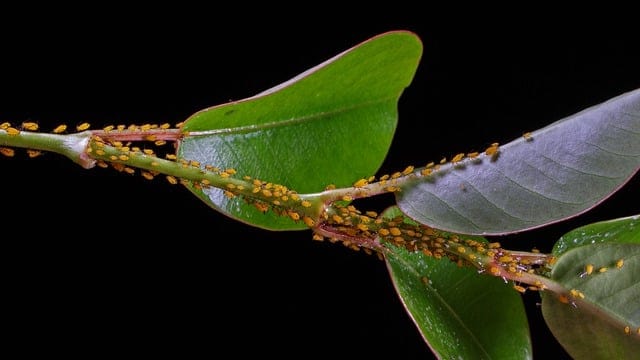
Aphids are sap-feeding insects that can penetrate the leaves of philodendrons and suck on their sap. They can be green, yellow, light brown, red, or light green in color. Aphids predominantly attack new growth on the plant.
The damage caused by aphids can lead to black spots on leaves. To get rid of aphids, one can use insecticidal soap or neem oil.
2. Spider Mites
Spider mites are one of the most common pests that can affect philodendrons. They are very small and difficult to see with the naked eye. Spider mites feed on the sap of the plant and can cause black spots on the leaves.
They are usually found on the underside of the leaves. To get rid of spider mites, one can use insecticidal soap or neem oil.
3. Mealybugs
Mealybugs are small, soft-bodied insects that are covered with a white, waxy substance. They feed on the sap of the plant and can cause black spots on the leaves. Mealybugs are usually found on the undersides of leaves and in the leaf axils. To get rid of mealybugs, one can use insecticidal soap or neem oil.
4. Scale Insects
Scale insects are small, immobile insects that attach themselves to the leaves and stems of philodendrons. They feed on the sap of the plant and can cause black spots on the leaves. Scale insects are usually found on the undersides of leaves and in the leaf axils. To get rid of scale insects, one can use insecticidal soap or neem oil.
In conclusion, pests such as aphids, spider mites, mealybugs, and scale insects can cause black spots on philodendron leaves. It is important to identify and get rid of these pests to prevent further damage to the plant. Using insecticidal soap or neem oil can be an effective way to control these pests.
Role of Nutrients and Fertilizers
Nutrient deficiencies can cause black spots on philodendron leaves. Therefore, it is important to provide the plant with the right amount of nutrients to keep it healthy. Fertilizers can be a great source of nutrients for philodendrons.
Philodendrons require a balanced fertilizer that contains nitrogen, phosphorus, and potassium. Nitrogen is essential for leaf growth, while phosphorus is important for root development. Potassium helps the plant to resist diseases and stress.
Over-fertilization can cause more harm than good. It can lead to salt buildup in the soil, which can damage the roots and cause nutrient deficiencies. Therefore, it is important to follow the instructions on the fertilizer package and not exceed the recommended dosage.
It is recommended to fertilize philodendrons once a month during the growing season, which is typically from spring to fall. During the winter, when the plant is dormant, fertilizing can be reduced or stopped altogether.
If the philodendron is showing signs of nutrient deficiencies, such as yellowing or black spots on the leaves, it may be necessary to adjust the fertilizer regimen. For example, if the plant is lacking nitrogen, a fertilizer with a higher nitrogen content can be used.
In conclusion, providing the right amount of nutrients through fertilization can help prevent black spots on philodendron leaves. However, it is important to be careful not to over-fertilize and cause salt buildup in the soil.
Preventing Black Spots

Preventing black spots on philodendron leaves is crucial to maintain their health and promote growth. Here are some tips to prevent black spots on philodendron leaves:
1. Environmental Issues
Philodendrons are susceptible to environmental issues such as low humidity, drafts, and sunburn. To prevent these issues, it is recommended to keep the plant in a well-ventilated area away from drafts and direct sunlight.
Philodendrons prefer a humidity level of 50-60%, which can be achieved by placing a tray of water near the plant or using a humidifier.
2. Watering and Drainage
Overwatering or underwatering can cause black spots on philodendron leaves. To prevent this, it is crucial to water the plant properly and ensure proper drainage. The soil should be moist but not waterlogged, and excess water should be drained out of the pot.
3. Pest Infestation
Pests such as spider mites, mealybugs, and scale can cause black spots on philodendron leaves. To prevent pest infestation, it is recommended to inspect the plant regularly and treat any infestation immediately. This can be done by using insecticidal soap or neem oil.
4. Fertilization
Overfertilization or lack of nutrition can cause black spots on philodendron leaves. To prevent this, it is recommended to fertilize the plant regularly with a balanced fertilizer. However, it is important not to overdo it, as too much fertilizer can cause more harm than good.
5. Care and Maintenance
Regular care and maintenance of philodendrons can prevent black spots on their leaves. This includes pruning the plant regularly to remove any dead or damaged leaves, repotting the plant when necessary, and ensuring proper air circulation around the plant.
By following these tips, philodendron owners can prevent black spots on their leaves and ensure a healthy and thriving plant.
Treatment of Black Spots

When it comes to treating black spots on philodendron leaves, it’s important to identify the underlying cause of the issue. Black spots can be caused by a variety of factors, including fungi, bacteria, and environmental stressors.
If the black spots are caused by a fungal infection, using a fungicide can be an effective treatment. Horticultural oil or neem oil can also be used to control fungal infections. It’s important to follow the instructions on the packaging carefully and apply the product as directed.
If the black spots are caused by a bacterial infection, using a bactericide can be helpful. Copper fungicide, baking soda solution, neem oil, and pyrethrins are all effective bactericides that can be used to control bacterial infections. Again, it’s important to follow the instructions on the packaging carefully and apply the product as directed.
In addition to using fungicides and bactericides, it’s important to take steps to address any environmental stressors that may be contributing to the issue. This can include adjusting watering practices, ensuring adequate drainage, and maintaining proper humidity levels.
If the roots of the plant are damaged or the plant is suffering from root rot, it may be necessary to repot the plant in fresh soil. It’s important to carefully remove any damaged roots and ensure that the new soil is well-draining.
To prevent the spread of plant diseases, it’s important to avoid misting the leaves of the plant and to avoid using a spray bottle to water the plant. Instead, water the plant at the base and avoid getting water on the leaves.
If pest infestation is the cause of the black spots, using a pesticide can help control the issue. It’s important to choose a pesticide that is safe for use on philodendrons and to follow the instructions on the packaging carefully.
Overall, treating black spots on philodendron leaves requires a combination of identifying the underlying cause of the issue and taking steps to address the issue. By using the appropriate fungicides, bactericides, and environmental controls, it’s possible to effectively treat black spots and prevent further damage to the plant.
Improving Plant Health
To prevent black spots on philodendron leaves, it is essential to maintain optimal plant health. Here are some tips to improve plant health and prevent black spots on philodendron leaves:
1. Mist the Plant
Misting the plant regularly can help increase the humidity level around the plant. It is especially helpful during dry winter months when indoor heating can cause the air to become dry. Use a spray bottle to mist the leaves and avoid getting water on the soil. Misting can also help to remove dust and debris from the leaves.
2. Use a Humidifier
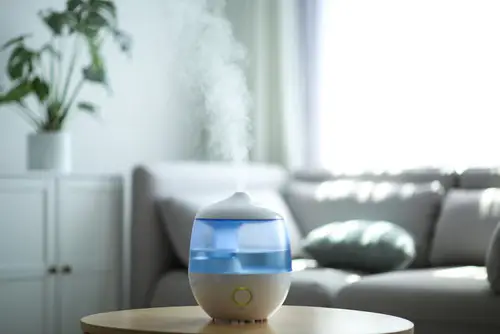
Using a humidifier is another effective way to increase humidity levels around the plant. Set it to a level of 50% to 60% for optimal plant growth. A humidifier can also help to prevent other problems such as dry skin and respiratory issues.
3. Improve Air Circulation
Good air circulation is essential for plant health. It helps to prevent the buildup of moisture around the leaves, which can lead to fungal infections and black spots. Place the plant in a well-ventilated area and avoid overcrowding the plant with other indoor plants.
4. Isolate Infected Plants
If you notice black spots on the philodendron leaves, isolate the infected plant immediately. This will help to prevent the spread of the infection to other plants. Remove any infected leaves and dispose of them properly.
5. Provide Proper Drainage
Poor drainage can lead to waterlogging, which can cause root rot and other problems. Ensure that the pot has proper drainage holes and use a well-draining soil mix. Water the plant only when the top inch of soil is dry.
6. Provide Bright, Indirect Light
Philodendrons thrive in bright, indirect light. Place the plant near a window that receives bright, indirect light for at least six hours a day. Avoid placing the plant in direct sunlight as it can scorch the leaves.
7. Use a Pebble Tray
A pebble tray can help to increase humidity levels around the plant. Fill a tray with pebbles and add water to just below the surface of the pebbles. Place the plant on top of the pebbles, ensuring that the water does not touch the pot. The water will evaporate, increasing the humidity level around the plant.
By following these tips, you can improve plant health and prevent black spots on philodendron leaves.
Frequently Asked Questions
What causes black spots on Philodendron leaves?
Black spots on Philodendron leaves can be caused by various factors such as bacterial or fungal diseases, watering issues, low humidity, pest infestation, and fertilizer issues.
Over-fertilizing or lack of nutrition can also cause black spots on the leaves. Salt build-up in the soil can also lead to black spots.
How do you treat black spots on leaves?
The treatment of black spots on Philodendron leaves depends on the cause. If the cause is over-fertilization, it is recommended to flush the soil with water to remove excess nutrients.
If the cause is a lack of nutrition, it is recommended to fertilize the plant. If the cause is pest infestation, use insecticides to control the pests. If the cause is fungal or bacterial disease, use fungicides or bactericides to control the disease.
What causes spots on Philodendron leaves?
Spots on Philodendron leaves can be caused by a variety of factors such as fungal or bacterial diseases, watering issues, low humidity, pest infestation, and fertilizer issues.
Over-fertilizing or lack of nutrition can also cause spots on the leaves. Salt build-up in the soil can also lead to spots.
How do you treat leaf spot disease in Philodendron?
To treat leaf spot disease in Philodendron, it is recommended to remove the affected leaves and dispose of them properly. Use fungicides or bactericides to control the disease.
Ensure that the plant is not over-watered and that the soil is well-draining. Increase humidity levels around the plant to prevent the disease from spreading.
What is Philodendron leaf spot disease?
Philodendron leaf spot disease is a fungal or bacterial disease that causes spots on the leaves of the plant. The spots can be black, brown, or yellow and can spread rapidly if not treated. The disease can be caused by over-watering, poor air circulation, and high humidity levels.
How can you prevent Philodendron leaf spot disease?
To prevent Philodendron leaf spot disease, ensure that the plant is not over-watered and that the soil is well-draining. Increase air circulation around the plant by placing a fan nearby.
Maintain the humidity levels around the plant to prevent the disease from spreading. Avoid over-fertilizing the plant and ensure that it is receiving enough nutrition.

Hey, I’m Lisa and I’ve been an avid gardener for over 30 years. I love writing, talking and living in the garden! Feel free to connect with me on my socials below

